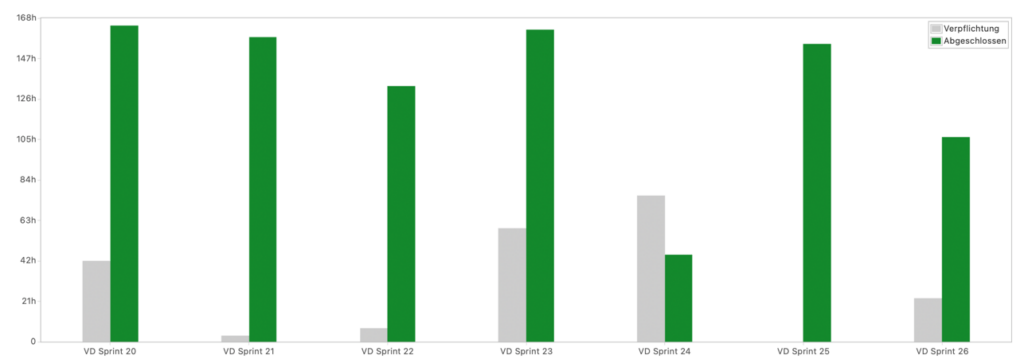
Author: Anna Schötz
· 7 mins read · 2,308 views
10 Scrum Metrics You Need to Know
Scrum is a framework and agile method that is all about team collaboration. It is mostly used in software development, but you can also apply it to other teams. Scrum is about shared structures, meetings, and teamwork in general. To measure this and to be able to make optimizations, there are the Scrum metrics.
What are Agile Scrum Metrics?
Metrics are measurement standards. Scrum Metrics are KPIs (Key Performance Indicators) with which the success of the company can be evaluated. They can determine if they have achieved business goals or if they are even on the right track. The goal is to be able to make improvements and identify problems that can then be solved. KPIs also allow you to track trends and compare the company’s performance with others. In Scrum, KPIs are also important. This is because Scrum teams work in sprints, which is a certain period, usually 1-4 weeks, during which the pre-planned tasks are completed. This makes it easier for the team to set goals and develop the right product at the right time.
In agile projects, the metrics can be powerful tools for planning, reviewing, adjusting, and understanding progress over time. From the success and failure rates, the Scrum team can see whether it needs to make optimizations or if the team did a good position. Duration and cost figures can highlight the benefits of agile projects and underpin the financial activities of an organization. They help the team see how productive they are in each phase. They are also an important part of the development process because they can also be used to assess the quality of the software. When you measure how productive a team works, weak points can be revealed and the problems can be worked on.
Why Do You Need Scrum Metrics?
This brings us to the next point: Why do you need Scrum Metrics? Metrics are essential to keeping track of an organization and its teams. They help plan, adjust, and understand how projects are progressing. Metrics help the team improve itself because teams that improve themselves are more sustainable and successful in the long run. However, this is a process that requires management. By tracking the team’s performance, agile metrics can directly impact the team’s continuous improvement.
What are Scrum Events?
In Scrum, various events occur repeatedly within a Sprint. The events help the team to gain meaningful metrics and insights. To work better with Scrum, here are 10 proven tools for easy agile project management.
1. Sprint Planning
The kick-off of every sprint is the sprint planning meeting. It serves to put together the Scrum team’s work package for the coming Sprint.
After a successful Sprint Planning:
- the Product Owner and the Development Team agree on the Sprint Goal (Outcome)
- and have jointly formed the Sprint Backlog. The Sprint Backlog contains all Product Backlog Items (Output) that have to be implemented in the Sprint to achieve the Sprint Goal
- For the product owner and the development team to achieve the two goals of the planning meeting, some prerequisites must be met
2. Daily Standup Explained
Daily Standups (also Daily Scrum) are a central practice for agile work. In this daily meeting, an agile team organizes itself and its work without the involvement of managers or external decision-makers. The participants of the Daily Standup stand together for a maximum of 15 minutes and talk in turn about the results of the previous day, barriers, and their plan for the current day. In this way, the team members make their status and major problems transparent and can help each other to remove barriers in order to achieve the jointly set goal.
3. Scrum Retrospective
The Scrum Retrospective is a mandatory event described in the Scrum Guide for the agile project management framework Scrum. The goal of the retrospective is to reflect on the experience (from the last sprint). Based on this, improvement measures are sought that can be directly implemented in the next sprint.
The Scrum Metrics
1. Sprint Goal Success Rates
- One way to measure agile project performance is the rate at which you achieve the Sprint goals. The sprint may not need all the requirements and tasks in the sprint backlog to achieve the goal. However, a successful sprint should result in a working product increment that meets the sprint goals and that meets the Scrum Team’s definition of Done. When you define the sprint goals and measure them afterward, you can a good understanding of the quality of the work.
- Sprint success routes are a good starting point for review and adjustment. Teams should always set the bar high enough that 100% completion of the sprint backlog is not necessarily the goal. Initial requirements should be completed one hundred percent, but teams should set their goals high enough that success rates of less than 100 percent in sprint backlog entries are considered a chance to learn and improve.
2. Escaped Defects
- Escaped defects are also an important metric.
- By recording key figures on defects, the development team can know how well it is preventing problems and whether it needs to improve its processes.
If the development team uses automated testing and continuous integration, it can track the number of defects at the building level in each sprint. By recording the number of build defects, the development team can know whether it needs to adjust development processes or environmental factors to catch the defects earlier in its development process.
The development team can record the number of defects found by the product owner when checking the completed functionality in each sprint. By capturing the User Acceptance Test defects, the development team and the product owner can see whether the processes need improvements. - The number of defects and whether the defects increase, decrease or remain light are good indicators to spark discussions about project processes and development techniques in sprint retrospectives.
3. Team Velocity
- You can use velocity to measure how many user stories you completed in the sprint. This makes it easier to determine how many tasks you can plan for the next Sprint.
- Velocity is a subjective measure based on a team’s definition of story points and captures the team’s progress. Therefore, you should not use it to compare teams.

4. Sprint Burndown
- The burndown chart is a graphical representation of the work that you already did and the work that you still need to do. It shows the completion of the various tasks during a sprint.
- Unit is hours or also story points.
- The goal here is that you complete the tasks by the end of the sprint. In addition, it is easier to assess whether the tasks from the sprint can be completed.

5. Time-to-market
- Time to market is the time it takes an agile project to create value by releasing usable functionality to the customer.
- Organizations can interpret this in different ways:
- If a product directly generates revenue, its value is the money that is earned from it
- When a product is used internally in the organization, its value is the ability of employees to use it, and it contains subjective factors based on what the product can do
- Consider the following points when measuring time to market:
- Measure the time from project launch until you see value for the first time
- Some Scrum teams release new product features for use at the end of each sprint
- Other Scrum teams plan releases after several sprints and provide product features in groups.
- For Scrum teams that use longer release times, the time to market is the number of days between releases
6. ROI
- Return on Investment (ROI) is the income generated by a product minus the project costs: cash income versus cash expenditure.
- ROI is fundamentally different in agile projects than in traditional projects. Agile projects have the potential to generate revenue with the first release and revenue can increase with each new release.
- Example:
| Scenario A is a waterfall project. The release will take place on June 30 of the same year, after all requirements have been completed. This project can generate a monthly turnover of 100,000 € from July onwards. Until the end of the year (6 months) the turnover is 600.000 €. | In scenario B, the features with the highest value and the highest risk are released incrementally after 4 one-week sprints starting on January 31st, i.e. five months earlier than in project A. The monthly revenue is lower at the beginning but increases with each month after the first release, it amounts to €50,000 in February, €60,000 in March, €70,000 in April, € 80.000 in May, €90.000 in June, €100.000 in July when the whole project is done. |
7. Capital restructuring
- If the cost of further development in an agile project is higher than the cost of those future developments, it is time to terminate the project.
- The product owner prioritizes the requirements partly according to whether they are capable of generating revenue or value. If there are only requirements left in the backlog that generate little revenue or value, a project can end before the project team has used up all of its budgets. The organization can then use the remaining funds from the old project to start a new, more valuable project.
The practice of transferring a budget from one project to another is called capital restructuring. - To calculate whether it makes sense to end the project, you need these key figures:
- The business value (V) of the remaining requirements in the product backlog.
- The actual cost (ACC) of the work involved in completing the requirements in the product backlog.
- The alternative costs (AC) or the value if the Scrum team is working on a new project.
8. Satisfaction surveys
- Customer satisfaction surveys measure the customer’s experience with the project, the process, and the Scrum team.
- The Scrum team can conduct customer surveys several times during a project, even at the beginning of the project, to get a benchmark for future comparisons.
- The Scrum team can use the survey results to investigate the processes, continue positive practices and adjust behavior where necessary.
9. Fluctuation
- Scrum projects tend to provide a better work ethic. One way to quantify morale is to measure staff turnover. Although fluctuation is not always directly related to position satisfaction, it can be helpful to look at the following metrics:
- Fluctuation in the Scrum team:
- A low fluctuation in the Scrum Team can be a sign of a healthy team environment.
- A high fluctuation in the Scrum Team can indicate problems in the project, in the organization, in the work, individual members of the Scrum Team, with burnout, with an ineffective Product Owner who forces the development team to make certain commitments, with incompatible personalities, with a Scrum Master who does not manage to remove obstacles or with the general dynamics in the team.
10. Diversity of qualifications
- Experienced scrum teams are typically more cross-functional than less mature and developed scrum teams. By eliminating single points of failure, teams progress faster and produce higher-quality products. Capturing the diversity of skills allows Scrum teams and managers to assess the growth of cross-functionality.
- Start by identifying the skills and levels of qualification that exist by knowing your team:
- Each person’s skills and level of qualification.
- Skills and qualification level of each team.
- Skills and qualification level in the organization.
Looking for Expert IT Solutions?
Subscribe to Our Newsletter for Exclusive Tips and Updates!
Stay ahead of tech challenges with expert insights delivered straight to your inbox. From solving network issues to enhancing cybersecurity and streamlining software integration, our newsletter offers practical advice and the latest IT trends. Sign up today and let us help you make technology work seamlessly for your business!


Share